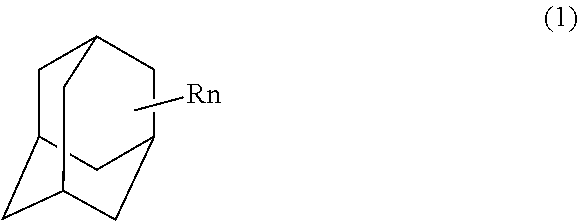Process for preparing adamantane polyol
a technology of adamantane polyol and adamantane, which is applied in the field of process for preparing adamantane polyol, can solve the problems of low recovery ratio, difficult to recover as a single compound, and high cost of ruthenium compounds, so as to achieve high yield and facilitate reactivation. effect of
- Summary
- Abstract
- Description
- Claims
- Application Information
AI Technical Summary
Benefits of technology
Problems solved by technology
Method used
Image
Examples
example 1
[0032]The following substances were put into a jacket-attached glass separable flask having a capacity of 2 L and provided with a magnet induction stirrer, a thermometer, a Dimroth condenser, and a pH electrode: 54 g of adamantane, 3.6 g of tricalcium phosphate as an inorganic adsorbent (for chemical use; produced by Wako Pure Chemical Industries, Ltd.; hereinafter, referred to simply as “TCP”), 2.7 g of ruthenium chloride-n hydrate (produced by N. E. Chemcat Corporation; the Ru content is 43%, i.e., about 1.2 g of Ru), 415 ml of ethyl acetate and 400 ml of water. 1200 g of 12 wt. % aqueous solution of sodium hypochlorite was dripped. At the same time, 10 wt. % sulfuric acid was dripped so that the pH value of the reaction solution would be 3.5. The time required to drip sodium hypochlorite was about 12 hours. During the dripping of sodium hypochlorite, the temperature was adjusted to be 55° C.±5° C. After the reaction was finished, 25% sodium hydroxide solution was dripped until th...
example 2
[0033]The same operation as in Example 1 was performed except that tricalcium phosphate having the ruthenium catalyst adsorbed thereto, which was separated by filtration in Example 1, was used with no further treatment, instead of newly adding tricalcium phosphate and ruthenium chloride-n hydrate. Like in Example 1, the water phase was analyzed by gas chromatography. As a result, the yield of 1,3,5-adamantane triol was 66%. The concentration of ruthenium in the resultant water phase was quantized by ICP emission spectrometry. The result was 3.7 ppm. The results are shown in Table 1.
example 3
[0034]The same operation as in Example 1 was performed except that 3.6 g of hydroxyapatite (for research use; produced by Wako Pure Chemical Industries, Ltd.; hereinafter, referred to simply as “HAP”) was added instead of tricalcium phosphate used in Example 1. Like in Example 1, the water phase was analyzed by gas chromatography. As a result, the yield of 1,3,5-adamantane triol was 66%. The concentration of ruthenium in the resultant water phase was quantized by ICP emission spectrometry. The result was 2.6 ppm. The results are shown in Table 1.
PUM
| Property | Measurement | Unit |
|---|---|---|
| carbon number | aaaaa | aaaaa |
| temperature | aaaaa | aaaaa |
| temperature | aaaaa | aaaaa |
Abstract
Description
Claims
Application Information
 Login to View More
Login to View More - R&D
- Intellectual Property
- Life Sciences
- Materials
- Tech Scout
- Unparalleled Data Quality
- Higher Quality Content
- 60% Fewer Hallucinations
Browse by: Latest US Patents, China's latest patents, Technical Efficacy Thesaurus, Application Domain, Technology Topic, Popular Technical Reports.
© 2025 PatSnap. All rights reserved.Legal|Privacy policy|Modern Slavery Act Transparency Statement|Sitemap|About US| Contact US: help@patsnap.com


